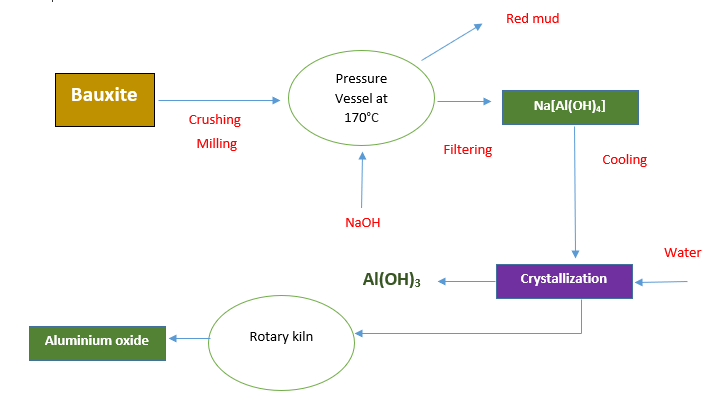Aluminium hydroxide occurs in nature as hydrargillite mineral, which means water and clay. It has both basic and acidic properties and thus is amphoteric in nature. It is represented as Al(OH)3. It is a typical metal oxide with hydroxyl bonds. It consists double layers of hydroxyl group with aluminium ions occupying two-thirds of the octahedral spaces between the layers.
As mentioned, aluminium hydroxide is amphoteric. When reacted with an acid, it acts as a Bronsted-Lowry base to produce salt, like the below reaction:
3HCl + Al(OH)3 → AlCl3 + 3H2O
When it reacts with a base, it acts as a Lewis acid. It takes as electron pair from the hydroxide ions and we have the below reaction:
Al(OH)3 + OH– → Al(OH)4–
Aluminium hydroxide can exist is different crystal structures, therefore, it is termed as a polymorph. The 4 different polymorphs of aluminium hydroxide are Gibbsite, Bayerite, Nordstrandrite and Doyleite. All the polymorphs consist layers of octahedral aluminium hydroxide. Aluminium atom is present at the centre, while the hydroxyl groups on the side. The polymorphs layers and stacking pattern is determined by the acidity, ions present and surface of minerals. Of all the polymorphs, gibbsite (aka hydrargillite) is the most chemically stable.
Aluminium hydroxide is a starting material for manufacturing other aluminium compounds like Aluminium sulphate, aluminium chloride, activated alumina and so on. Freshly obtained aluminium hydroxide precipitate as gels, which can used as flocculants. When the gel is dried, aluminium hydroxide powder is obtained.
- Pharmaceutical industry Aluminium hydroxide is an antacid for humans and animals. It reacts with acid in the stomach and reduces the stomach acidity to a great extent. It also relieves symptoms of ulcers and heartburns. Precipitated aluminium hydroxide is also used as adjuvant in vaccines.
- Intermediate ChemicalsAluminium hydroxide is the basic material for many aluminium compounds. In industries, it is added to cement to facilitate the drying. It is also used for the production ceramic and glass as it can increase the melting point of glass. When aluminium hydroxide is combined with a polymer, the newly made material will gain fire retardant properties.
- Paper industry Aluminium hydroxide acts as an extender and bodying agent in the manufacturing of paper. It is used as a filler in paper as it disperses readily and retains for a long time during manufacturing. It is also used as a paper coating agent in the paper industry.
- Metal industry Aluminium oxide is important for the manufacturing of pure aluminium metal via the Hall-Héroult process. The Hall-Héroult process involves dissolving aluminium oxide in molten cryolite, and electrolysing the molten salt bath at 940–980°C, giving a 99.5% – 99.8% yield of pure aluminium.
Aluminium hydroxide is manufactured by Bayer process commercially. In Bayer process, bauxite is dissolved in sodium hydroxide at a temperature of 270 °C. The waste is removed and aluminium hydroxide is precipitated from sodium aluminate

